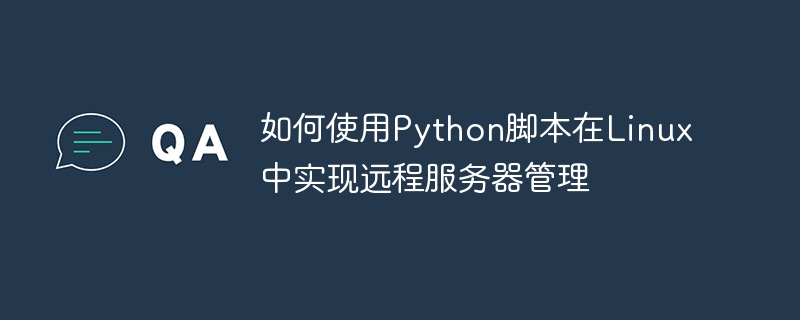 Backend Development
Backend Development
 Python Tutorial
Python Tutorial
 How to implement remote server management in Linux using Python scripts
How to implement remote server management in Linux using Python scripts
How to implement remote server management in Linux using Python scripts

How to implement remote server management in Linux using Python scripts
引言:
在现代互联网时代,远程服务器管理成为了一项重要的任务。对于Linux服务器,我们可以使用Python脚本来实现远程管理的各种功能,包括文件传输、执行命令、监控系统等。本文将介绍How to implement remote server management in Linux using Python scripts,并提供具体的代码示例。
一、安装Python库
在开始之前,我们需要安装一个名为"paramiko"的Python库,该库提供了SSH2的实现,可以方便地实现SSH远程连接和操作。可以使用以下命令安装该库:pip install paramiko
二、连接远程服务器
使用paramiko库可以非常方便地连接远程服务器。下面是一个示例代码,演示了如何连接一个远程服务器并执行命令:
import paramiko
# 远程服务器地址和登录凭据
hostname = "远程服务器地址"
username = "用户名"
password = "密码"
# 创建SSH客户端
client = paramiko.SSHClient()
client.set_missing_host_key_policy(paramiko.AutoAddPolicy())
# 连接远程服务器
client.connect(hostname, username=username, password=password)
# 执行命令
stdin, stdout, stderr = client.exec_command("ls")
# 输出命令执行结果
print(stdout.read().decode())
# 关闭连接
client.close()三、文件传输
在远程服务器管理中,文件传输是一项常见的任务。将本地文件传输到远程服务器或从远程服务器下载文件,可以使用paramiko库中的相关函数实现。以下是一个上传本地文件到远程服务器的示例代码:
import paramiko
# 远程服务器地址和登录凭据
hostname = "远程服务器地址"
username = "用户名"
password = "密码"
# 创建SSH客户端
client = paramiko.SSHClient()
client.set_missing_host_key_policy(paramiko.AutoAddPolicy())
# 连接远程服务器
client.connect(hostname, username=username, password=password)
# 上传文件
sftp = client.open_sftp()
sftp.put("本地文件路径", "远程文件路径")
sftp.close()
# 关闭连接
client.close()四、监控服务器
在远程服务器管理中,监控服务器状态是一项重要的任务。通过执行命令获取服务器的各种系统信息,可以实现简单的服务器监控功能。以下是一个获取服务器CPU利用率的示例代码:
import paramiko
# 远程服务器地址和登录凭据
hostname = "远程服务器地址"
username = "用户名"
password = "密码"
# 创建SSH客户端
client = paramiko.SSHClient()
client.set_missing_host_key_policy(paramiko.AutoAddPolicy())
# 连接远程服务器
client.connect(hostname, username=username, password=password)
# 执行top命令获取CPU利用率
command = "top -bn1 | grep %Cpu | awk '{print $2}'"
stdin, stdout, stderr = client.exec_command(command)
# 输出CPU利用率
cpu_usage = stdout.read().decode().strip()
print("CPU利用率: {}%".format(cpu_usage))
# 关闭连接
client.close()总结:
使用Python脚本在Linux中实现远程服务器管理可以极大地提高工作效率。通过paramiko库,我们可以轻松地连接远程服务器、执行命令、进行文件传输和监控服务器状态。以上提供的代码示例可以作为你实现远程服务器管理的起点,相信你可以根据实际需求进行修改和扩展。希望本文对你有所帮助!
The above is the detailed content of How to implement remote server management in Linux using Python scripts. For more information, please follow other related articles on the PHP Chinese website!

Hot AI Tools

Undresser.AI Undress
AI-powered app for creating realistic nude photos

AI Clothes Remover
Online AI tool for removing clothes from photos.

Undress AI Tool
Undress images for free

Clothoff.io
AI clothes remover

Video Face Swap
Swap faces in any video effortlessly with our completely free AI face swap tool!

Hot Article

Hot Tools

Notepad++7.3.1
Easy-to-use and free code editor

SublimeText3 Chinese version
Chinese version, very easy to use

Zend Studio 13.0.1
Powerful PHP integrated development environment

Dreamweaver CS6
Visual web development tools

SublimeText3 Mac version
God-level code editing software (SublimeText3)

Hot Topics
 PHP and Python: Different Paradigms Explained
Apr 18, 2025 am 12:26 AM
PHP and Python: Different Paradigms Explained
Apr 18, 2025 am 12:26 AM
PHP is mainly procedural programming, but also supports object-oriented programming (OOP); Python supports a variety of paradigms, including OOP, functional and procedural programming. PHP is suitable for web development, and Python is suitable for a variety of applications such as data analysis and machine learning.
 Choosing Between PHP and Python: A Guide
Apr 18, 2025 am 12:24 AM
Choosing Between PHP and Python: A Guide
Apr 18, 2025 am 12:24 AM
PHP is suitable for web development and rapid prototyping, and Python is suitable for data science and machine learning. 1.PHP is used for dynamic web development, with simple syntax and suitable for rapid development. 2. Python has concise syntax, is suitable for multiple fields, and has a strong library ecosystem.
 Linux Architecture: Unveiling the 5 Basic Components
Apr 20, 2025 am 12:04 AM
Linux Architecture: Unveiling the 5 Basic Components
Apr 20, 2025 am 12:04 AM
The five basic components of the Linux system are: 1. Kernel, 2. System library, 3. System utilities, 4. Graphical user interface, 5. Applications. The kernel manages hardware resources, the system library provides precompiled functions, system utilities are used for system management, the GUI provides visual interaction, and applications use these components to implement functions.
 PHP and Python: A Deep Dive into Their History
Apr 18, 2025 am 12:25 AM
PHP and Python: A Deep Dive into Their History
Apr 18, 2025 am 12:25 AM
PHP originated in 1994 and was developed by RasmusLerdorf. It was originally used to track website visitors and gradually evolved into a server-side scripting language and was widely used in web development. Python was developed by Guidovan Rossum in the late 1980s and was first released in 1991. It emphasizes code readability and simplicity, and is suitable for scientific computing, data analysis and other fields.
 How to check the warehouse address of git
Apr 17, 2025 pm 01:54 PM
How to check the warehouse address of git
Apr 17, 2025 pm 01:54 PM
To view the Git repository address, perform the following steps: 1. Open the command line and navigate to the repository directory; 2. Run the "git remote -v" command; 3. View the repository name in the output and its corresponding address.
 Golang vs. Python: Key Differences and Similarities
Apr 17, 2025 am 12:15 AM
Golang vs. Python: Key Differences and Similarities
Apr 17, 2025 am 12:15 AM
Golang and Python each have their own advantages: Golang is suitable for high performance and concurrent programming, while Python is suitable for data science and web development. Golang is known for its concurrency model and efficient performance, while Python is known for its concise syntax and rich library ecosystem.
 Golang vs. Python: Performance and Scalability
Apr 19, 2025 am 12:18 AM
Golang vs. Python: Performance and Scalability
Apr 19, 2025 am 12:18 AM
Golang is better than Python in terms of performance and scalability. 1) Golang's compilation-type characteristics and efficient concurrency model make it perform well in high concurrency scenarios. 2) Python, as an interpreted language, executes slowly, but can optimize performance through tools such as Cython.
 Python vs. C : Learning Curves and Ease of Use
Apr 19, 2025 am 12:20 AM
Python vs. C : Learning Curves and Ease of Use
Apr 19, 2025 am 12:20 AM
Python is easier to learn and use, while C is more powerful but complex. 1. Python syntax is concise and suitable for beginners. Dynamic typing and automatic memory management make it easy to use, but may cause runtime errors. 2.C provides low-level control and advanced features, suitable for high-performance applications, but has a high learning threshold and requires manual memory and type safety management.





